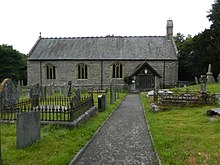| St Derfel's Church | |
|---|---|
| Eglwys Derfel Sant | |
 | |
 | |
| 52°55′17″N 3°30′58″W / 52.9213°N 3.5162°W / 52.9213; -3.5162 | |
| Location | Llandderfel, Gwynedd |
| Country | Wales |
| Denomination | Anglican (Church in Wales) |
| History | |
| Status | Parish church |
| Founder(s) | Saint Derfel |
| Dedication | Saint Derfel |
| Architecture | |
| Functional status | Active |
| Heritage designation | Grade I |
| Designated | 20 October 1966 |
| Administration | |
| Diocese | St Asaph |
| Archdeaconry | Montgomery |
| Parish | Llandderfel |
St Derfel's Church is located on the northern edge of the village of Llandderfel, Gwynedd, Wales. The church is dedicated to Saint Derfel, a Welsh saint. Derfel is reputed to have lived in the 5th/6th century and been a warrior of King Arthur, and one of only seven of his knights who survived the Battle of Camlann, at which Arthur himself was killed. Derfel then became a monk and founded two churches, that at Llandderfel, and a chapel near Cwmbran in South Wales. In the Middle Ages, a pilgrimage cult developed around Derfel, and an effigy of his horse (or a stag), the Ceffyl Derfel (Derfel's horse), is located in the church. The church was largely rebuilt in the early 1600s, although its origins go back to a pre-Norman clas. It is a Grade I listed building.
History
The village of Llandderfel stands in the eastern part of Gwynedd, equidistant between Llandrillo, Denbighshire and Lake Bala. The church stands on the western edge of the village and is dedicated to Saint Derfel, a Welsh saint. Derfel reputedly lived in the 5th/6th century and was one of only seven warriors of King Arthur who survived the Battle of Camlann, at which Arthur himself was killed. Derfel became a monk and founded two churches, that at Llandderfel, and a chapel near Cwmbran in South Wales. In the Middle Ages, a major pilgrimage cult developed around Derfel, and an effigy of his horse (or a stag), the Ceffyl Derfel (Derfel's horse), is located in the church. The horse stood next to a wooden effigy of Derfel, in full armour and an object of veneration. The statue of Derfel was removed on the orders of Thomas Cromwell in 1538, despite the villagers' offer of the then huge sum of £40 to Ellis Price, Cromwell's enforcer in North Wales, to spare it. The statue was taken to London where it was used as kindling for the pyre on which the martyr John Forest was burnt. The effigy of the stag survives although its head was removed in the 18th century.
The church dates from the early 16th century, although its origins go back to a pre-Norman clas. It was restored in 1870. The poet Dewi Havhesp, who lived in the village for many years, is buried in the churchyard. The church remains an active parish church in the Diocese of St Asaph and occasional services are held.
Architecture and description
The church has a combined nave and chancel with a porch and vestry forming a cruciform plan, with a bellcote. The building material is local slate stone with a Welsh slate roof. The Royal Commission on the Ancient and Historical Monuments of Wales (RCAHMW) describes the interior as a "well-preserved example of a late medieval building, retaining good original external character and interior detail". The Tudor roof is original. Richard Haslam, Julian Orbach and Adam Voelcker, in their 2009 edition Gywnedd, in the Buildings of Wales series, call the Ceffyl Derfel, "a medieval relic of exceptional rarity". St Derfel's is a Grade I listed building. Its lychgate is listed at Grade II.
Gallery
References
- ^ "Church Heritage Record 1423: St Derfel, Llandderfel (Pilgrim church)". Church in Wales. Retrieved 10 September 2024.
- Gray, Madeleine (2 May 2013). "Welsh History Month: St Derfel and the Stag - icon or idol?". Wales Online. Retrieved 10 September 2024.
- ^ Haslam, Orbach & Voelcker 2009, pp. 623–624.
- "Three Saints, Two Wells & a Welsh Parish by Tristan Gray Hulse". Archived from the original on 27 May 2013. Retrieved 13 May 2009.
- ^ Cadw. "Parish Church of St Derfel (Grade I) (4654)". National Historic Assets of Wales. Retrieved 10 September 2024.
- ^ "St Derfel's Church, Llandderfel (43870)". Coflein. RCAHMW. Retrieved 10 September 2024.
- Robert Thomas Jenkins. "Roberts, David (Dewi Havhesp; 1831-1884), poet". Dictionary of Welsh Biography. National Library of Wales. Retrieved 3 January 2022.
- Cadw. "Lychgate at the Parish Church of St Derfel (Grade II) (24583)". National Historic Assets of Wales. Retrieved 10 September 2024.
Sources
- Haslam, Richard; Orbach, Julian; Voelcker, Adam (2009). Gwynedd. The Buildings of Wales. New Haven, US and London: Yale University Press. ISBN 978-0-300-14169-6. OCLC 1023292902.


